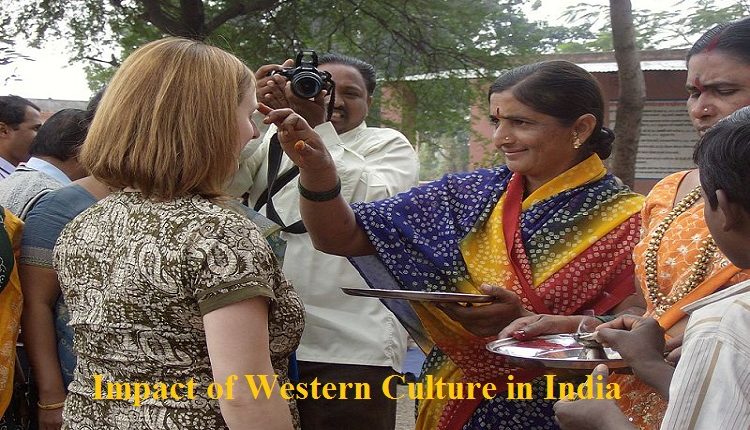Impact of Western Culture in India: A Critical Analysis
Effect of the Impact of Western Culture in India: A Critical Analysis of Western Culture V/s Indian Culture
Impact of Western Culture in India over Indian Culture is visible in every sphere of life.
Modern India evolving in a mixed culture due to Impact of Western Culture in India
Before we start with this topic, we must first know what culture means.
Culture has been defined in a number of ways. It is said to be the learned and shared behavior of a community of interacting human beings.
Culture describes what people develop to enable them to adapt to their world, such as language, gestures, tools to enable them to survive and prosper, customs and traditions that define values and organize social interactions, religious beliefs and rituals, and dress, art, and music to make symbolic and aesthetic expressions.
Culture determines the practices and beliefs that become associated with an ethnic group and provides its distinctive identity.
Every culture is enriched with some good and bad features.
Broadly the world has been classified into the western and the eastern culture. The East-West dichotomy is a sociological concept used to describe perceived differences between Western cultures and the Eastern world.
Cultural rather than geographical in the division, the boundaries of East and West are not fixed but vary according to the criteria adopted by individuals using the term.
Aspects of culture
Now in this paper, we will discuss few aspects that vary widely between the western culture and the Indian culture.
Impact of Western Culture in India
Religion & spiritual beliefs
Arts & crafts
Family life, community & society
Family and its values are the key part of Indian culture, which doesn’t exist in the western culture. Being in a family, giving love to your loved ones and respect to your elders, is the root of INDIAN culture. Sorry to say, but the family doesn’t exist in reality except in terminology, in western culture.
Either people have live-in relations or they get divorced, if they are not compatible with each other. So, how could a person in their right mind have mental peace in such an environment, where relationships are breaking every other day. Because of the lack of family values and existence of a family life, people end up doing drugs, crimes etc.
Even studies and research also proved that western civilization suffers more from depression and emotional misbalance than their eastern counter parts.
Below are few major differences that we can easily find between the two societies:
- Westerners place a high value on having fun. This doesn’t mean that they don’t care about serious issues. If they see someone upset, they will often assume that the person wants to be left alone, unless they are good friends. While, Indians tend to value people being concerned about them when they are upset or depressed, if your questions are not welcome, they will indicate it, but will generally appreciate the concern.
- Westerners can become intimate quite quickly in friendships, but that doesn’t mean that they are committed. Commitment takes longer to happen. In the India, commitment is more closely tied to intimacy. There is an expectation that friendship, after a deep talk, will continue at the same level.
- Westerners can have affectionate guy-girl friendships without any romantic interest. Be cautious in assuming a Westerner is romantically interested, even if their behavior appears intimate. If you’re not kissing or holding hands, you’re probably not dating. Indians tend to have a much lower threshold of what is considered a relationship. What Westerners might consider a normal guy-girl friendship can be read as definite interest in the other person. In particular, spending time alone with someone of the opposite sex is a strong sign of interest.
- Westerners tend to be more honest about their skills and to value a high self-esteem. They are not necessarily being arrogant if they openly admit that they are good at something. Indians are less likely to volunteer their talents. They will wait for someone to ask them to use their skills, rather than jumping in and volunteering them.
- Equality between men and women is valued in the West. To imply that women are weaker, more emotional or that they need protection can be offensive. Chivalry is still alive and well in the India. Many women expect doors to be opened for them, to be served first at dinner, and for help in carrying heavy things.
- Westerners do not take their work as personally as Indians tend to. It is not that they don’t care about their work. They are more relaxed about their jobs. Indians tend to take their work personally. Tromping across their freshly cleaned floor, or showing up late when you are to be working with them can be seen as disrespectful.




Pandey sahab, your article is completely discuss every aspect though it’s not completely correct. There are some parts which are not correct. See, I’m teaching Intercultural Communication in a college in my country (INDONESIA). Actually there’s a theory invented by Edward T. Hall called “High Context Culture & Low Context Culture”. High Context Culture is Asian, African, Southern European (Spanish, Portuguese, Italian) culture. It characterized by collectivism, layers of relationship (elders generation & child generation) which differ to behave, family first, maintain relationship for long term & the weaknesses are not punctual & procrastination. While Low Context Culture is Western culture: Northern American, Southern American, Western European. Low Context Culture basically is Individualistic, prioritize privacy, short term relationship (only relate when it comes to work or certain project) & the strengths are punctual and get things done effectively & efficiently.
You still caught up in stereotype so you say Westerners don’t have family. They have family. Otherwise how come words aunt, uncle, nephew, niece, grandfather, grandmother, father-in-law, mother-in-law, son-in-law, daughter-in-law exist in English, French, German language? They have family life. Just like Hindustani, they also celebrate festivals with family. If you ever watch Hollywood movies or American TV series, you will see they celebrate Thanksgiving, Christmas & Hanukkah (Jewish religious festival) by lunch & supper/dinner together with joint family. On Thanksgiving whole roasted turkey served for whole family dining. On Christmas Eve, after return from church whole family gather to exchange Christmas gift that placed under Christmas tree. Even President of America also celebrate Thanksgiving & Christmas with similar traditions.